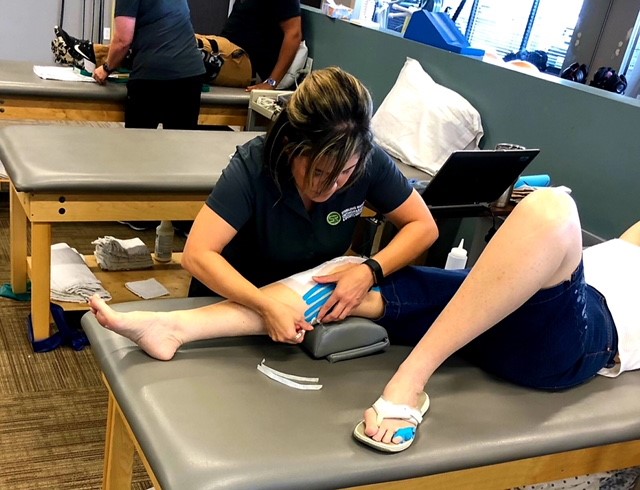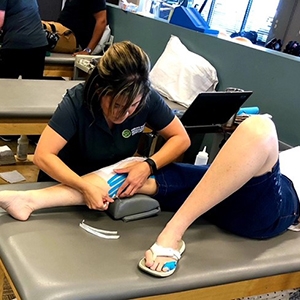
In the 2008 Olympics most of us caught a glimpse of this beautiful pattern of multi colored tape on the legs, hips, bellies and shoulders of athletes. What is it? Why was it on these high level athletes? Can this tape help me? This amazing tape can be used on athletes and weekend warriors as well. Kinesiology tape can be sold by many different names, just like facial tissue or cotton swabs, but basically it is made with the same idea in mind. The tape can be applied to decrease pain, diminish swelling, smooth out scars, or for posture and movement enhancement. How can kinesiology tape help me?
Pain: Case studies have been published on the use of K-tape for nerve entrapment, brachial plexus injuries, low back pain, neck pain from acute whiplash, and knee and plantar fasciitis pain with positive outcomes. Pain relief comes from sensory and movement information carried to the brain with the use of K-tape on the skin. As more movement and sensory information is perceived by the brain less pain is relayed to the brain.
Fluid dynamics: K-tape decompresses the skin and its underlying tissue to help decrease swelling. The assistance offered by movement of fluid allows the patient to comfortably exercise after an acute injury, with patients reporting improvement of symptoms such as tightness, pain, hardness, discomfort, fullness and tingling.
Scars: Scar tissue tends to be a general term for any type of soft tissue restriction or shortening. K-tape can be applied as a “shearing force” to a scar to pull and soften the tissue. Along with stretching and manual techniques, K-tape application can be beneficial in lengthening the tissue and encouraging it to align into a beneficial movement pattern.
Posture and movement enhancement: Loss of ideal posture represents a structural problem that affects stability, movement, joint mechanics, and efficient muscle function. K-tape’s feedback on the skin allows for greater movement awareness to promote better positioning. K-tape helps enhance movement because it stimulates the skin’s receptors and assists the body’s ability to “know where it is in space”. This allows for better movement and performance, decreasing the risk of injury. K-tape applied to the back of the shoulder can allow a person to notice when they “slump” because of the additional tension.
K-tape has been shown to help rehabilitate injury, decrease joint swelling, and diminish scars and enhance posture and functional movement. You don’t have to be a high-level athlete to enjoy the benefits of K-tape. Sterling Ridge Orthopaedics has PTs and PTAs trained in K-tape application.






